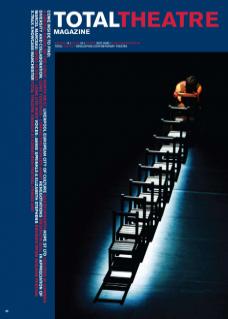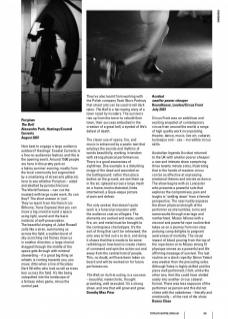How best to engage a large audience outdoors? Hastings’ Coastal Currents is a free-to-audiences festival, and this is the opening event. Around 1500 people are here in this pretty park on a balmy summer evening; mostly from the local community but augmented by a smattering of street arts glitterati, here to see whether Periplum – aided and abetted by pyrotechnicians The World Famous – can cut the mustard with large scale work. So can they? The short answer is ‘yes’. They’ve learnt from the French (Jo Bithume, Trans Express) that you can move a big crowd around a space using light, sound and the basic instincts of self-preservation. The beautiful singing of Juliet Russell calls like a siren, summoning us across the field; a sudden burst of sky-scorching red flames draw us in another direction; a large chariot dragged through the middle of the space gets through with minimal stewarding – if a great big thing on wheels is coming towards you, you move; ditto when a line of faceless Dark Wraiths who look as tall as trees tear across the field. It’s like being catapulted into the landscape of a fantasy video game, minus the control pad.
They’ve also learnt from working with the Polish company Teatr Biuro Podrozy that street arts can be used to tell dark tales: The Bell is a harrowing story of a town razed by invaders. The survivors rise up from the terror to rebuild their town, their success embodied in the creation of a great bell, a symbol of life’s defeat of death.
The clever use of space, fire, and music is enhanced by a poetic text that employs the sounds and rhythms of words beautifully, working in tandem with strong physical performances. There is a good awareness of sightlines. One example is a disturbing image of the dead and wounded on the battleground: rather than place bodies on the ground, we see them up in the air, splayed across a large mesh on a frame; trunks distorted, limbs intertwined, a Goya-esque picture of pain and defeat.
The only section that doesn’t quite work is a funeral procession with the audience cast as villagers. The elements are evoked and water, earth, fire, air, and metal must be brought to the centrepiece chariot/pyre. It’s the sort of thing that can’t be rehearsed; the only way to find out is to do it, and doing it shows that there needs to be some rethinking on how best to create chains of command and spin the action out and away from the central knot of people. This, no doubt, will have been taken on board and will be worked on for future performances.
The Bell, on its first outing, is a success – beautiful, melancholic, thought provoking, well executed. It’s a strong show, and one that will grow and grow.

